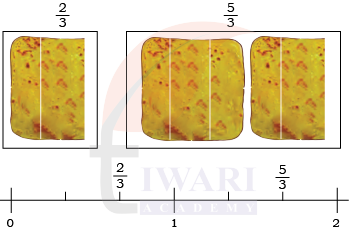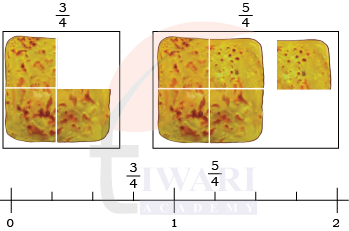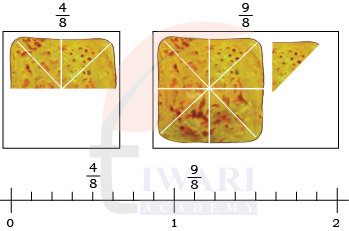NCERT Solutions for Class 5 Maths Mela Chapter 2 Fractions for Session 2025-26 based on new edition. Maths Mela solutions provide clear explanations and step-by-step answers to help students understand fractions easily. Covering topics like equivalent fractions, comparing fractions and fractions greater than one, these solutions follow the latest NCERT guidelines. With engaging examples and practical exercises, they make learning fun and effective. Perfect for revision and exam preparation, ensuring proper understanding for Class 5 students.
Class 5 Maths Mela Chapter 2 Solutions
Class 5 Maths Mela Chapter 2 MCQ
Class 5 Math Magic Chapter 2 Solutions
Class 5 Maths all Chapters Solutions
Fractions Class 5 Maths Mela Chapter 2 Solutions
Page 19
Let Us Do
1. In groups of 3 or 4, find different ways of making a whole with different fraction pieces from your kit. Write the equivalent fractions for the following that you may find in the process.
(a) 1/3 = = =
(b) 1/4 = = =
(c) 1/5 = = =
(d) 1/6 = = =
Do you see how to generate equivalent fractions for any given fraction?
Discuss in class.
See Solution(a) 1/3 = 2/6 = 3/9 = 4/12
(b) 1/4 = 2/8 = 3/12 = 4/16
(c) 1/5 = 2/10 = 3/15 = 4/20
(d) 1/6 = 2/12 = 3/18 = 4/24
The pattern is to multiply both the numerator and denominator by the same number.
For example: If
1/3 × (2/2) = 2/6,
1/3 × (3/3) = 3/9,
1/3 × (4/4) = 4/12
So, to generate equivalent fractions, just multiply the numerator and denominator by the same number.
2. Find the following using your kit. You can also shade and check by shading the following. The first one is partially done for you.
A. How many (1/6)s make (1/3)s?
See SolutionTwo (1/6)s make (1/3).
B. How many (1/8)s make
(a) 1/4?
(b) 1/2?
See Solution(a) Two (1/8)s make 1/4.
(b) Four (1/8)s make 1/2.

C. How many (1/12)s make
(a) 1/2
(b) 1/3
(c) 1/4
(d) 1/6?

See Solution(a) Six (1/12)s make 1/2.
(b) Four (1/12)s make 1/3.
(c) Three (1/12)s make 1/4.
(d) Two (1/12)s make 1/6.

3. Do as instructed using your fraction kit.
• Make a whole using only 1/6 and 1/12 pieces.
See Solution3 pieces of 1/6: 3 × (1/6) = 3/6 = 6/12
6 pieces of 1/12: 6 × (1/12) = 6/12
Total: 6/12 + 6/12 = 12/12 = 1
• Make a whole using 1/12, 1/4 and 1/2 pieces.
See SolutionConverting all pieces to common denominator = 12
1/2 = 6/12
1/4 = 3/12
1/12 = 1/12
Now, taking:
1 piece of 1/2 = 6/12
1 piece of 1/4 = 3/12
3 pieces of 1/12 = 3 × 1/12 = 3/13
Total = 6/12 + 3/12 + 3/12 = 12/12 = 1
• Make a whole using any five pieces of the same size.
See Solution5 pieces of 1/5: 5 × (1/5) = 5/5 = 1
• Make a whole using any seven pieces.
See Solution7 pieces of 1/7: 7 × (1/7) = 7/7 = 1
Class 5 Maths Mela Chapter 2 Question Answers
Page 22
Let Us Do
1. Fill in the blanks with equivalent fractions. There may be more than
one answer.
(a) 1/7 = _____
(b) 2/3 = _____
(c) 3/4 = _____
(d) 3/5 = _____
See SolutionMultiply Numerator and Denominator with the same number:
(a) 1/7 = 2/14 = 3/21
(b) 2/3 = 4/6 = 8/12
(c) 3/4 = 6/8 = 9/12
(d) 3/5 = 6/10 = 9/15
2. Put a tick (✔) against the fractions that are equivalent.
(a) 2/3 and 3/4
(b) 3/5 and 6/10
(c) 4/12 and 2/6
(d) 6/9 and 1/3
See Solution(a) 2/3 and 3/4
(b) 3/5 and 6/10 (✔)
(c) 4/12 and 2/6 (✔)
(d) 6/9 and 1/3
3. Fill in the boxes such that the fractions become equivalent.
(a) 2/5 = ▢/10
(b) 3/4 = ▢/16
(c) 4/7 = 8/▢
(d) 5/9 = 25/▢
See Solution(a) 2/5 = 4/10
(b) 3/4 = 12/16
(c) 4/7 = 8/14
(d) 5/9 = 25/45
Class 5 Maths Mela Chapter 2 Answers Guide
Page 23
Let Us Do
1. Compare the fractions given below using < and > signs.
(a) 1/4 ___ 3/4
(d) 7/8 ___ 3/8
(b) 3/5 ___ 4/5
(e) 5/10 ___ 6/10
(c) 5/7 ___ 2/7
(f) 2/6 ___ 1/6
See Solution(a) 1/4 < 3/4 (d) 7/8 > 3/8
(b) 3/5 < 4/5
(e) 5/10 < 6/10 (c) 5/7 > 2/7
(f) 2/6 > 1/6
Page 23
Let Us Do
1. Compare the following fractions using < and > signs.
(a) 3/8 ______ 3/7
(b) 4/9 ______ 4/10
(c) 2/7 ______ 2/5
(d) 5/7 ______ 5/6
(e) 6/9 ______ 6/10
(f) 7/9 ______ 7/11
See Solution(a) 3/8 < 3/7 (b) 4/9 > 4/10
(c) 2/7 < 2/5
(d) 5/7 < 5/6 (e) 6/9 > 6/10
(f) 7/9 > 7/11
Question Answers of Class 5 Maths Mela Chapter 2
Page 28
Let Us Do
1. Use parathas and number lines to show the following fractions in your
notebook.
(a) 2/3 and 5/3
Answer:

(b) 3/4 and 5/4
Answer:

(c) 4/8 and 9/8
Answer:

2. Circle the fractions that are greater than one (whole). How do you know?
Discuss your reasoning in the class.

Answer:

Page 29
Let Us Do
1. Compare the following fractions using 1 as a reference. Share your reasoning in the class.
(a) 8/7 ______ 9/15
(b) 13/20 ______ 17/15
(c) 7/6 ______ 8/8
(d) 6/6 ______ 19/12
(e) 12/9 ______ 4/5
(f) 15/5 ______ 16/4
See Solution(a) 8/7 > 9/15
(b) 13/20 < 17/15 (c) 7/6 > 8/8
(d) 6/6 < 19/12 (e) 12/9 > 4/5
(f) 15/5 < 16/4
Class 5 Maths Mela Chapter 2 All Answers
Page 30
Let Us Do
1. Circle the fractions below that are equal to 1/2.

Answer:

2. Some fractions are written in the box below. Circle the fractions that are less than half. How do you know? Discuss your reasoning in the class.

See SolutionI can compare it to 1/2 either by:
• Using number line
• Using equivalent fractions
• Looking at numerator and denominator.

Page 31
Let Us Do
1. Compare the following fractions. Where possible, compare the fractions with 1/2.

Answer:

What does Class 5 Maths Mela Chapter 2 Fractions teach?
Class 5 Maths Mela Chapter 2 Fractions introduces students to the idea of representing parts of a whole using numbers. It begins with simple fractions like 1/2, 1/3 and 1/4, then moves to comparing fractions, identifying which is bigger or smaller and finding fractions of different wholes. The chapter also focuses on equivalent fractions, showing that different-looking fractions can represent the same value. It uses fraction kits, grids and shaded diagrams to make concepts visual and easy to grasp. Students also learn about improper fractions and mixed numbers, which are fractions greater than one whole. By combining real-life examples like pizzas and parathas with activities, the chapter makes learning fractions engaging, practical and connected to everyday experiences, improving both understanding and application skills.
Is Class 5 Maths Mela Chapter 2 based on the 2025-26 new edition?
Yes, the solutions for Class 5 Maths Mela Chapter 2 Fractions are completely aligned with the 2025-26 new edition of the NCERT textbook. This ensures that every example, exercise and activity matches the current syllabus requirements. The new edition includes updated illustrations, more interactive activities and clearer step-by-step explanations, making it easier for students to grasp the concepts. The focus is not only on solving numerical problems but also on building conceptual clarity through visual aids like number lines, shaded grids and fraction kits. The updated content also introduces students to new real-life scenarios for better understanding. Since the curriculum changes aim to make mathematics more activity-based and less abstract, these solutions strictly follow the fresh format, ensuring students are well-prepared for school tests, annual exams and day-to-day application of fraction concepts.
Is Class 5 Maths Mela Chapter 2 solutions useful for exams?
Yes, the solutions for Class 5 Maths Mela Chapter 2 Fractions are extremely useful for exams because they cover all NCERT questions in a clear, step-by-step manner. Each problem is solved with explanations so that students understand not only the answer but also the reasoning behind it. The inclusion of visual methods like grids, number lines and fraction strips ensures complete clarity, which is important for answering application-based questions. Practice exercises reinforce key skills like finding equivalent fractions, comparing fractions and working with mixed numbers. Since the solutions follow the latest 2025-26 new edition, students are prepared for any updated exam formats. They also include a variety of solved examples and “Let Us Do” activities, which improve problem-solving speed, accuracy and confidence during tests.
Can students self-study with Class 5 Maths Mela Chapter 2?
Yes, the solutions for Class 5 Maths Mela Chapter 2 Fractions are designed for independent learning. They are written in simple, student-friendly language, with plenty of visual aids and real-life examples that make concepts easy to relate to. Each topic starts with an explanation, followed by worked-out examples and then exercises for practice. Step-by-step methods guide students through problems without skipping important reasoning steps, ensuring they learn the “how” and “why” of each solution. Visual models like shaded shapes, grids and number lines help students grasp abstract ideas faster. The “Let Us Do” and “Try This” sections encourage active participation, making learning interactive. Since the answers match the 2025-26 new edition, students can be confident that their self-study aligns perfectly with their classroom lessons and exams.


